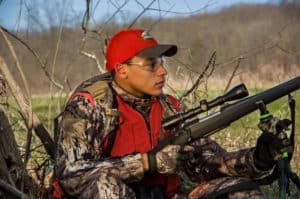by M.D. Johnson,
I grew up in Ohio, which was in the early 1970s was a shotgun-only state for whitetail hunters who used modern firearms, as it is today. As such, I never actually had a “first deer rifle” until I moved to Washington at the age of 30.

A kid’s first deer rifle should be selected only after careful consideration that includes a young hunter’s size, the hunting situation, budget, and even your state’s firearm restrictions.
My first deer-specific firearm was a Remington Model 1100 16-gauge, complete with a smoothbore slug barrel and iron sights. It was a more-than-satisfactory rig, and the one with which I killed my inaugural whitetail. Conversely, my first true deer rifle, also made by the folks at Remington, was a Model 700 BDL in .243 Winchester. She was in ’93, and is to this day, one of the finest, most accurate rifles I’ve owned.
Personal history lesson behind us now, I begin this piece to make a point, and that being your child’s first deer rifle might not be a rifle at all; that is, if you live in a state like Ohio or Illinois.
Whether traditional centerfire rifle or shotgun, what goes into the decision-making process when it comes time to procure your young hunter’s first deer-specific firearm?
Here’s the short list of tips; things to consider before you run out and buy that new Christmas gift for your favorite young deer hunter.
Evaluate the Situation
The first question to answer is simple enough—centerfire rifle or shotgun? If you, like I did back in the day, live in a shotgun-only state, then it’s obviously wise to consider a shotgun deer firearm. Fortunately, manufacturers such as Remington and Mossberg offer combination packages that include both a rifled slug barrel and a traditional full-length vent rib shotgun barrel. Remington’s Model 870 Express 20-gauge combo, for example, features a 23-inch fully rifled slug barrel and a 26-inch vent rib with interchangeable choke tubes. This is an ideal package, not only for the young hunter, but it is a favorite among seasoned whitetail and turkey hunters, too—myself very much included.
Evaluate Your Child
Let’s assume you and your young hunter have laid the groundwork in terms of safe firearms handling practices. Now it’s time to truly evaluate your child as to what they can physically handle in regards to a deer-specific firearm of their own.
For you shotgunners, the choice is relatively simple—the 20-gauge. Although many of us started our hunting careers with a .410, the little sub-bore is really quite limiting, not to mention the fact finding ammunition can prove a challenge.
A 12-gauge might be a possibility, especially if (1) your child’s physical abilities can work with the recoil generated by a 12, and (2) your budget can work with a (recoil-reducing) autoloader. A light-recoiling 20-gauge offers immeasurable versatility above and beyond a .410, yet doesn’t present the weight and recoil issues a possibility with the 12-bore. Is the 20-gauge too small for whitetails, wild turkeys, or waterfowl? Absolutely not.
But does a centerfire rifle make more sense given your home state and hunting regulations? If so, let’s continue.
Choose a Caliber
Now it’s time to talk centerfire rifles and calibers. Like shotguns, rifles and recoil go hand-in-hand. Rifles—or rifle calibers to be precise—should be chosen based not only depending upon the task to be performed, but the young hunter performing said task.
Many—and I do mean many—will argue, but I’ll stand by this statement. A parent or guardian would be hard-pressed to purchase a better caliber centerfire for a young hunter than the .243 Winchester. True, there’s quite a bit to be said about the .270 and .25-06, attributes like bullet selection and species versatility. However, consider the .243 Winchester’s light recoil, which is roughly 50 percent that of a 2 3/4-inch 20-gauge shooting a 1-ounce charge at 1,200 FPS. Consider also today’s wide range of high-performance bullets—Winchester, Hornady, Barnes, and Sierra. Plus there’s the .243’s reputation for accuracy. It’s tough to disagree. Toss in the long list of manufacturers currently building quality production rifles in .243 caliber, and the choice for a first deer rifle almost becomes a no-brainer.
There are no absolutes when it comes time to decide on your young hunter’s first deer-specific firearm. Physical size, ability, hunting situation, and, of course, budget will all play parts in the final equation. However, there’s ample information available, including recommendations from the firearms manufacturers themselves. The bottom line? As you’ve so often said to your young charge—do your homework.
The Union Sportsmen’s Alliance website is designed to provide valuable articles about hunting, fishing and conservation for members of AFL-CIO affiliated labor unions and all sportsmen and sportswomen who appreciate hunting and fishing and want to preserve our outdoor heritage for future generations. If you would like your own story and experience from the outdoors to be considered for our website, please email us at [email protected].




